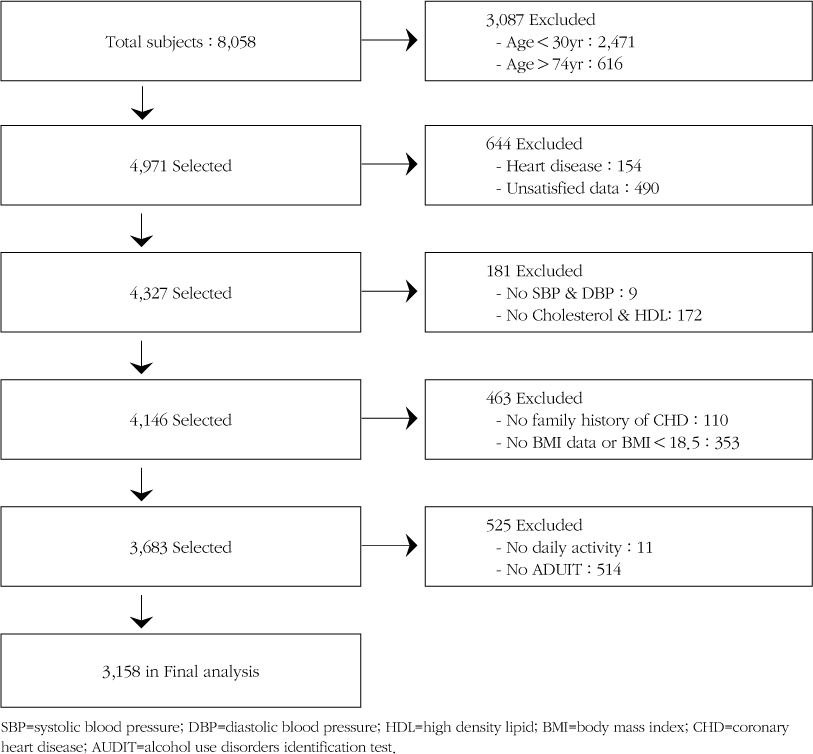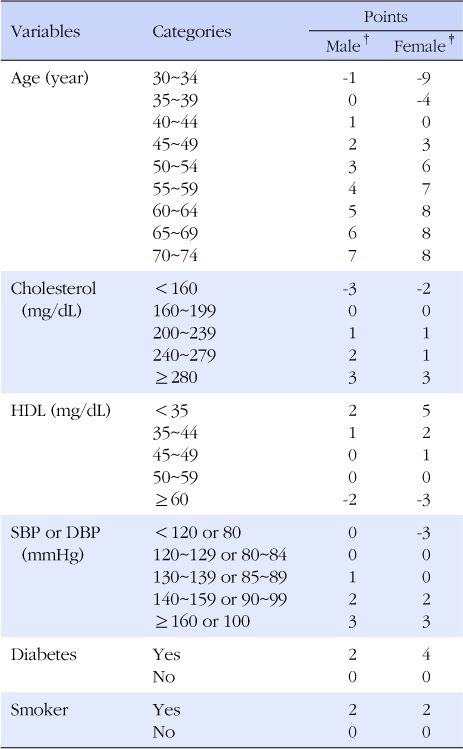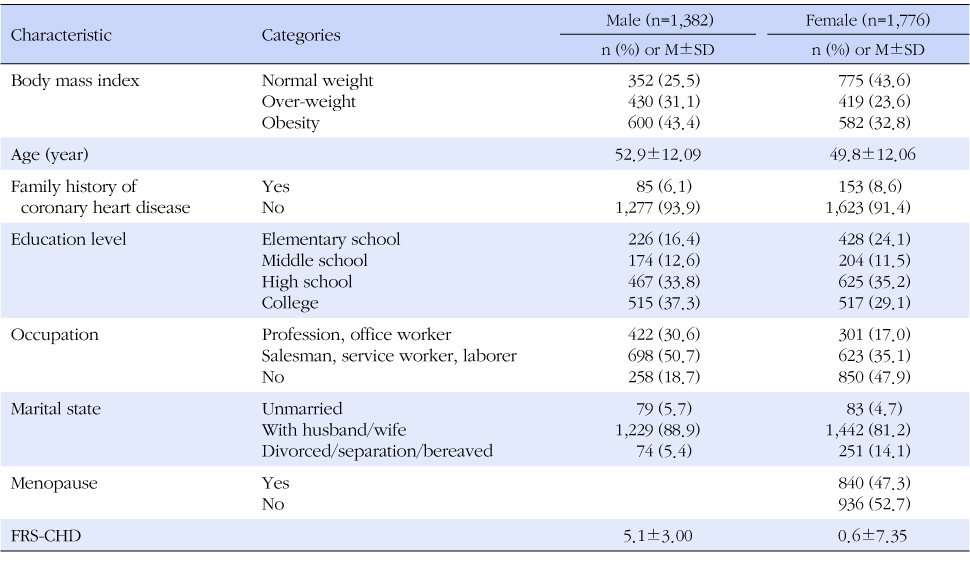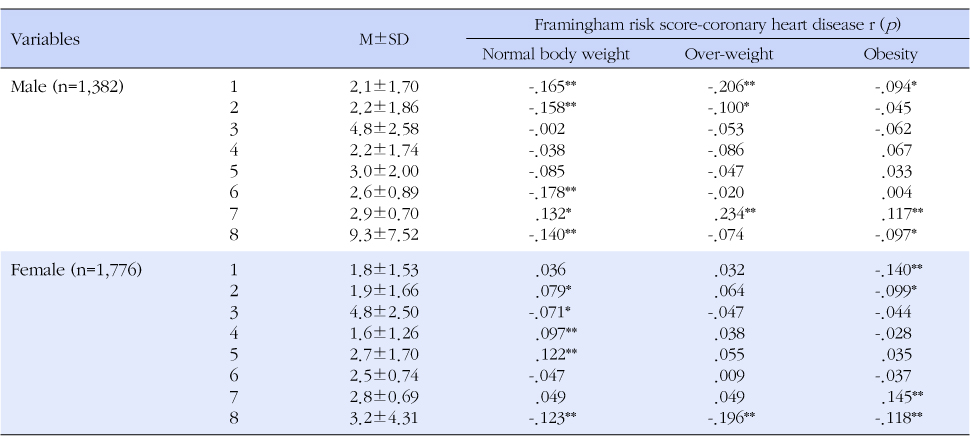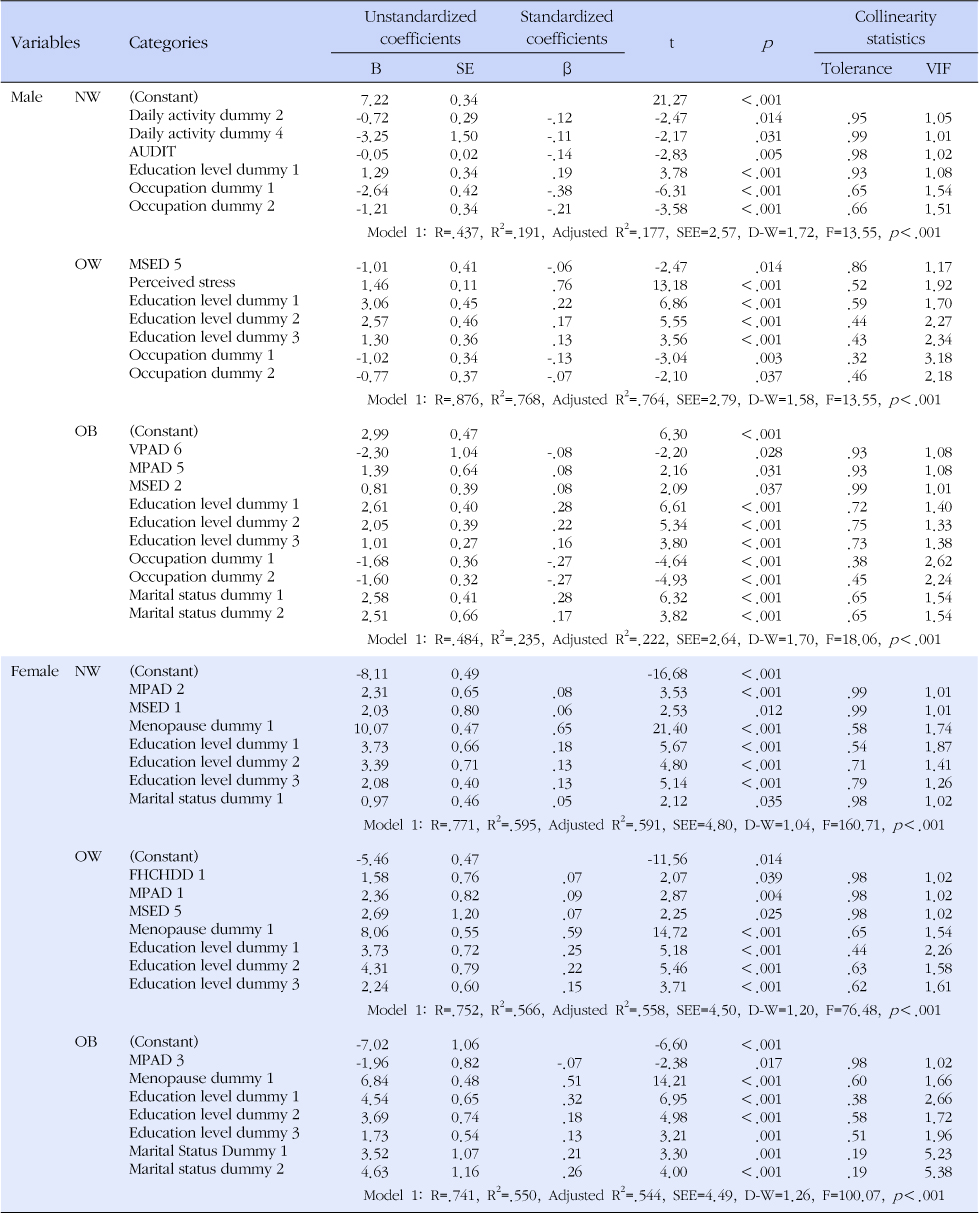References
2. Mendis S, Puska P, Norrving B, eds. Global Atlas on cardiovascular disease prevention and control Geneva: World Health Organization in collaboration with the World Heart Federation and the World Stroke Organization; 2011.
5. Wilson PW, D'Agostino RB, Levy D, Belanger AM, Silbershatz H, Kannel WB. Prediction of coronary heart disease using risk factor categories. Circulation 1998;97(18):1837–1847.
http://dx.doi.org/10.1161/01.cir.97.18.1837.
6. Murray CJ, Lauer JA, Hutubessy RC, Niessen L, Tomijima N, Rodgers A, et al. Effectiveness and costs of intervention to lower systolic blood pressure and cholesterol: A global and regional analysis on reduction of cardiovascular-disease risk. Lancet 2003;361(9359):717–725.
Cited by Choi EH, Seo JY. Framingham risk score by general characteristics and physical activity: Based on the 4th Korean national health and nutrition examination survey. Korean Public Health Research. 2011;37(1):85-96.
8. Fletcher GF, Blair SN, Blumenthal J, Caspersen C, Chaitman B, Epstein S, et al. Statement on exercise: Benefits and recommendations for physical activity programs for all Americans. A statement for health professionals by the committee on exercise and cardiac rehabilitation of the council on clinical cardiology, American Heart Association. Circulation 1996;94(4):857–862.
http://dx.doi.org/10.1161/01.cir.94.4.857.
9. Strath SJ, Swartz AM, Bassett DR Jr, O'Brien WL, King GA, Ainsworth BE. Evaluation of heart rate as a method for assessing moderate intensity physical activity. Med Sci Sports Exerc 2000;329 Suppl. :S465–S470.
http://dx.doi.org/10.1097/00005768-200009001-00005.
11. Warburton DER, Katzmarzyk PT, Rhodes RE, Shephard RJ. Evidence-informed physical activity guidelines for Canadian adults. Can J Public Health 2007;98Suppl 2. :S16–S68.
http://dx.doi.org/10.1139/H07-123.
12. Maeda S, Miyauchi T, Goto K, Matsuda M. Alteration of plasma endothelin-1 by exercise at intensities lower and higher than ventilatory threshold. J Appl Physiol (1985) 1994;77(3):1399–1402.
13. Maeda S, Miyauchi T, Sakane M, Saito M, Maki S, Goto K, et al. Does endothelin-1 participate in the exercise-induced changes of blood flow distribution of muscles in humans. J Appl Physiol (1985) 1997;82(4):1107–1111.
14. Whitlock G, Lewington S, Sherliker P, Clarke R, Emberson J, Halsey J, et al. Body-mass index and cause-specific mortality in 900,000 adults: Collaborative analyses of 57 prospective studies. Lancet 2009;373(9669):1083–1096.
http://dx.doi.org/10.1016/s0140-6736(09)60318-4.
17. Zheng W, McLerran DF, Rolland B, Zhang X, Inoue M, Matsuo K, et al. Association between body-mass index and risk of death in more than 1 million Asians. N Engl J Med 2010;364(8):719–729.
http://dx.doi.org/10.1056/nejmoa1010679.
18. Romero-Corral A, Montori VM, Somers VK, Korinek J, Thomas RJ, Allison TG, et al. Association of bodyweight with total mortality and with cardiovascular events in coronary artery disease: A systematic review of cohort studies. Lancet 2006;368(9536):666–678.
http://dx.doi.org/10.1016/s0140-6736(06)69251-9.
19. Choi MC, Song YH, Lee SY, Woo JT. Framingham risk scores by occupational group: Based on the 3rd Korean national health and nutrition examination survey. Korean J Occup Environ Med 2009;21(1):63–75.
20. Yang IS, Choi DH, Kang YH. The awareness of cardiovascular risk factors and its correlates in patients with coronary artery diseases. J Korean Acad Adult Nurs 2010;22(5):499–508.
22. Kim KA, Kim JS, Kim MS. Predictors of coronary heart disease risk in healthy men and women. J Korean Acad Nurs 2007;37(7):1039–1048.
23. Gill T. Epidemiology and health impact of obesity: An Asia Pacific perspective. Asia Pac J Clin Nutr 2006;15Suppl. :3–14.
25. Choi EH, Seo JY. Framingham risk score by general characteristics and physical activity: Based on the 4th Korean national health and nutrition examination survey. Korean Public Health Res 2011;37(1):85–96.
26. Park SH, Kang YH, Park HY. Alcohol consumption and the coronary heart disease-related risk factors in Korean adults: The third Korea National Health and Nutrition Examination Survey (KNHANES III), 2005. Korean J Nutr 2008;41(3):232–241.
27. Agarwal DP. Cardioprotective effects of light-moderate consumption of alcohol: A review of putative mechanisms. Alcohol Alcohol 2002;37(5):409–415.
Cited by Park SH, Kang YH, Park HY. Alcohol consumption and the coronary heart disease- Related risk factors in Korean adults: The third Korea National Health and Nutrition Examination Survey (KNHANES III), 2005. Journal of Nutrition and Health. 2008;41(3):232-241.
